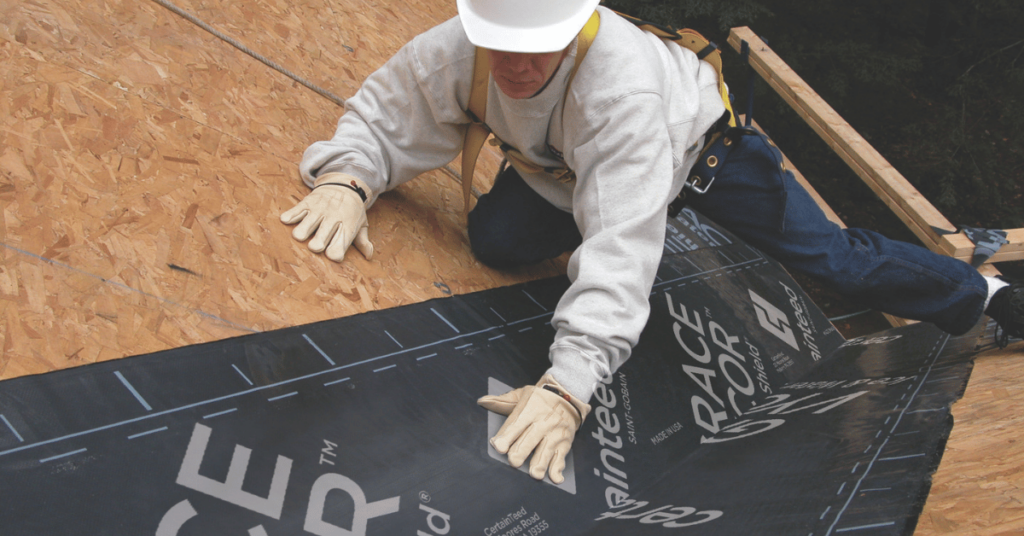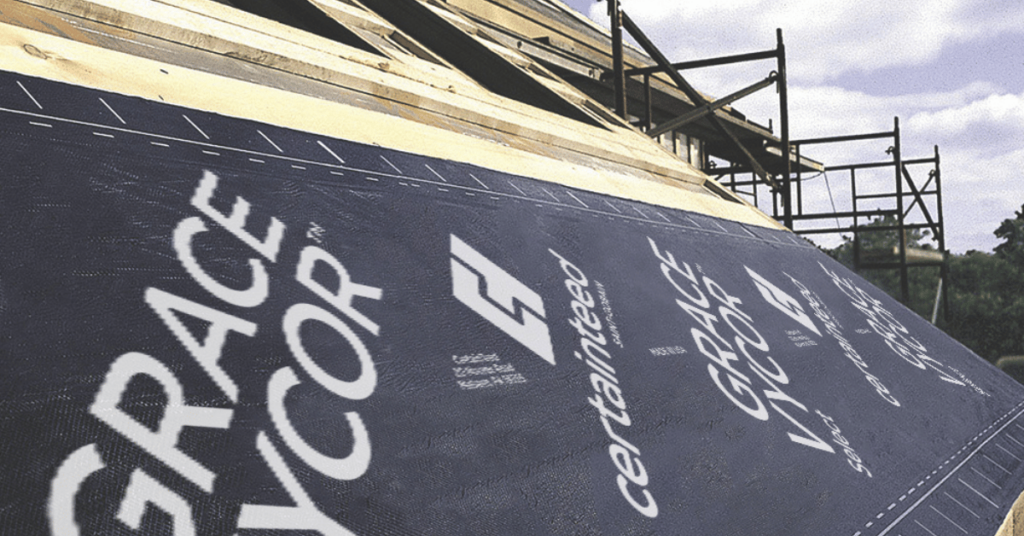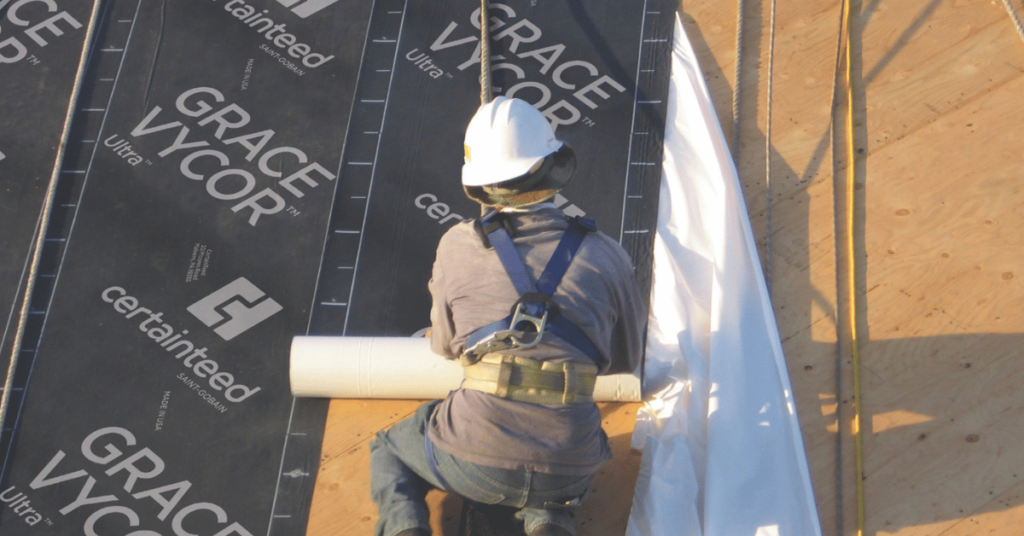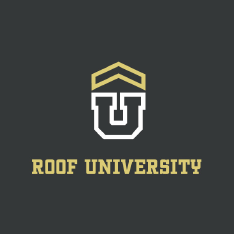Roofing Underlayment 101: Roofing underlayment is an essential yet often overlooked part of roof anatomy, acting as a crucial layer of protection between the roof deck and the shingles. This guide explains the types of underlayment—felt, synthetic, and Ice & Water Shield—detailing each one’s features, advantages, and limitations to help homeowners and roofers make informed choices. We’ll cover installation tips, durability, and cost-effectiveness, providing insights for various climates and roof types. Understanding these options empowers you to select the best underlayment for your needs and ensure the longevity and resilience of your roofing system.

Introduction to Roofing Underlayment
Roofing underlayment is a protective barrier, applied directly on the roof deck, which lies beneath the outermost roofing layer. This layer is a secondary weatherproofing defense, safeguarding the home from moisture, wind, and even intense sunlight. Many underlayment options are designed to work in tandem with shingles, extending the life of the entire roofing system. Trusted manufacturers like GAF and CertainTeed emphasize that high-quality underlayment can substantially enhance roofing durability, especially in areas prone to severe weather.
An additional underlayment layer adds vital protection in places with significant climate variation, such as areas affected by storms or snow. Underlayment choices, including traditional felt, engineered synthetic materials, and advanced Ice & Water Shield options, give roofers and homeowners multiple levels of defense. By adding another layer of moisture and temperature resistance, underlayment helps prevent costly roof damage over time.
Why Roofing Underlayment is Essential
Protection Against Moisture and Leaks
Roofing underlayment is particularly important in protecting against moisture intrusion, which can lead to mold, rot, and structural weakening. High-quality synthetic underlayments, like those produced by IKO and Atlas Roofing, are designed with multiple layers of polypropylene for superior waterproofing. These underlayments provide an extra moisture barrier when installed under shingles, keeping the roof deck dry even if water penetrates the shingles.
Moisture resistance is crucial in storm-prone areas, as even a small amount of water infiltration can cause significant long-term damage. By sealing off the decking, roofing underlayment keeps costly repairs at bay, especially if other layers become worn or compromised over time.
Additional Weatherproofing
Roofing underlayment enhances protection against extreme temperatures, helping the roof withstand diverse weather conditions. For instance, Tamko manufactures underlayments with UV protection, preserving roof integrity during hot summers by preventing material breakdown. This weatherproofing feature is especially beneficial for steep-slope roofs that receive more direct sunlight.
Regions that experience intense weather—whether heat, heavy rain, or snow—benefit from the additional temperature resilience that underlayment provides. This extra layer ensures that shingles maintain their function and structure for longer periods, regardless of the weather conditions they encounter.
Enhancing Shingle Performance and Longevity
Underlayment is a support structure for shingles, allowing them to perform at their best over the years. For instance, Owens Corning offers synthetic underlayment options that enhance the performance of their shingles, ensuring they remain stable and durable. This compatibility boosts shingle lifespan, as underlayment prevents moisture buildup and limits exposure to UV rays, which can cause shingles to warp, crack, or lose their granules over time.
Underlayment like Ice & Water Shield provides superior adherence in climates with freezing and thawing cycles, ensuring shingles stay in place and retain their protective capabilities despite fluctuating conditions.

Types of Roofing Underlayment
Overview of the Main Types
Roofing underlayment comes in three main types: felt, synthetic, and Ice & Water Shield. Each has distinct properties and uses. Choosing the right one depends on factors like budget, roof slope, climate, and intended longevity.
Felt Underlayment
What is Felt Underlayment?
Felt underlayment, or “tar paper,” is made from organic or synthetic materials infused with asphalt. Malarkey Roofing Products manufactures felt underlayment, which is widely used due to its affordability and simplicity.
Pros of Felt Underlayment
Felt is a budget-friendly option, making it a popular choice for standard residential roofs. It works effectively as a moisture barrier in milder climates or for short-term solutions. Felt is also easy to work with and is available in varying thicknesses, such as 15-pound or 30-pound weights, allowing homeowners to choose based on budget and required durability.
Cons of Felt Underlayment
However, felt underlayment can be heavy and may deteriorate under prolonged exposure to sunlight or rain before installation is complete. It can also tear or crack, especially in areas with high foot traffic. Alternative underlayment types are often preferred for longer-lasting installations.

Synthetic Underlayment
What is Synthetic Underlayment?
Synthetic underlayment is made from woven or non-woven polypropylene or polyethylene, offering a modern and highly durable solution. Leading brands like Pabco Roofing and CertainTeed produce synthetic underlayment options that are both lightweight and long-lasting.
Pros of Synthetic Underlayment
Synthetic underlayment offers high resistance to tearing and is highly water-resistant, making it ideal for areas with heavy rainfall or wind. Additionally, it is lighter than felt, easier to handle, and provides excellent grip, which can improve safety during installation. Synthetic materials also have UV-resistant properties, allowing for temporary exposure to sunlight without damage.
Cons of Synthetic Underlayment
While more durable, synthetic underlayment is generally more expensive than felt and may require specialized fasteners to ensure proper installation. It also demands a higher skill level for effective application and often requires professional installation to maximize its benefits.

Ice & Water Shield
What is Ice & Water Shield?
Ice & Water Shield, a premium self-adhering waterproof underlayment, is designed for vulnerable roof areas like valleys, eaves, and edges. BP (Building Products of Canada) offers a range of Ice & Water Shield products engineered explicitly for leak prevention in cold-weather regions.
Pros of Ice & Water Shield
This underlayment type provides the best protection for roofs in areas with heavy snow or ice. It prevents ice dams and offers waterproofing even if shingles are damaged. It’s especially beneficial for homes with low-slope roofs, where water and ice can accumulate.
Cons of Ice & Water Shield
The primary downside of Ice & Water Shield is its cost, which is higher than that of both felt and synthetic options. Additionally, it’s generally used only in specific roof areas rather than as a full-roof underlayment.

Detailed Comparison: Felt, Synthetic, and Ice & Water Shield
Durability and Longevity
Compared to felt, synthetic and Ice & Water Shield underlayments provide superior longevity. Felt typically has a shorter lifespan and is more susceptible to environmental damage, while synthetic underlayment and Ice & Water Shield products from CertainTeed and IKO offer extended durability.
Weather Resistance
Ice & Water Shield outperforms felt and synthetic underlayments in cold climates or areas with heavy rainfall, where moisture resistance is critical. Synthetic underlayment offers moderate weather resistance and works well in diverse climates due to its tear-resistant construction.
Cost Comparison
Felt is the most cost-effective choice, making it suitable for budget-conscious homeowners. Synthetic underlayment and Ice & Water Shield are pricier but provide more excellent durability and protection, especially in severe climates.
Ease of Installation
Felt and synthetic underlayment are generally easy to install, with synthetic underlayment being lighter and easier to handle on the roof. Ice & Water Shield, however, requires careful handling and proper adhesion, which professional roofers best perform.
How to Choose the Right Underlayment for Your Roof
Factors to Consider
Selecting the right underlayment involves assessing your roof’s slope, climate, and budget. Homeowners in humid or storm-prone areas may opt for synthetic or Ice & Water Shield to better withstand moisture.
Best Underlayment by Roof Type
Synthetic underlayment provides excellent adhesion and resilience for steep-slope roofs. For roofs with valleys, Ice & Water Shield offers unmatched protection against water pooling and ice dams.
Professional Tips for Installation
Professional installation by a licensed roofer is recommended to maximize the benefits of underlayment, especially for complex underlayments like Ice & Water Shield. Trusted brands like Five Points Roofing provide expert guidance on underlayment choices and application methods.
Common Roofing Underlayment FAQs
- How Long Does Each Underlayment Type Last?
- Felt typically lasts around 15 years, while synthetic underlayment can last 20-30 years. Ice & Water Shield has an extended lifespan in targeted areas.
- Is Synthetic Underlayment Suitable for DIY Installation?
- Knowledgeable DIYers can install synthetic underlayment but is safest with professional guidance due to installation complexity.
- Why Use Ice & Water Shield in Specific Roof Areas?
- This premium underlayment is designed for high-risk areas prone to leaks, such as valleys and eaves.
Conclusion and Next Steps
In conclusion, felt, synthetic, and Ice & Water Shield each offer unique benefits for protecting your roof. While felt remains affordable for standard applications, synthetic underlayment, and Ice & Water Shield provide advanced weather resistance and durability for homes in harsher climates. Choosing the proper underlayment and working with a professional, such as those from Roof University or Five Points Roofing, ensures a long-lasting, resilient roofing system. Contact a local roofing expert to learn more about the best underlayment for your roof’s needs.
Parks
Matt is Five Points Roofing's VP of Business Development, directly in charge of company growth and building a true contracting brand that is trusted by millions of homeowners. It’s not all business for Matt though, being 6’5”, he’s an avid amateur beach volleyball player and golfer. Competition is his thing. Happily married to his wife Laura, they also have a giant 72 pound ex-racing greyhound that’ll run laps around you.
Roof University is the place if you're a roofer, property owner, or insurance adjuster.
